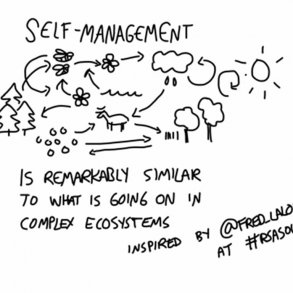By Brent Lowe and Susan Basterfield and originally published at leadtogether.co
Some of the questions that often come up when we talk about organizations that lead together, who don’t have managers in the traditional sense are “What happens when there’s a team member that’s causing a problem? Or “What happens when there’s somebody that the organization needs to let go of?”
In this blog post, Lead Together co-authors Brent Lowe and Susan Basterfield share their thoughts on how self-managing organizations could approach exiting colleagues.
Question: What are some of the common exit paths
Brent Lowe:
I’ll start by talking about the unhealthy paths that I think most of us have probably seen in one form or another.
One is the fast exit. This says “somebody hasn’t done something or they’ve done something that I’m not happy about so let’s just move them out of the organization by five o’clock today.” It’s fast, it’s harsh. It’s unkind to the individual, and often unhealthy to the organization.
The second is slow. This says “There’s a problem, we ignore it…until it becomes the, the pebble in the shoe that just keeps getting bigger and bigger and bigger. Eventually, it almost flops back then to the fast exit approach.
The third is “this person needs to be fixed, and so we’re going to fix them.” That really isn’t our role with our colleagues. Nobody needs to be “fixed”. Our belief is everybody is whole, there may be some opportunities for learning and growth that we can help introduce individuals to, but nobody needs to be fixed.
I would say we’ve experienced all three of those. It’s easy for those things to creep into lead together organizations as well, because it’s very hard, I think, for individuals to figure out “well, what else is possible?”
Susan Basterfield:
“I think that it’s also quite geographically and culturally dependent, this particular challenge. In some countries, it’s quite easy and straightforward, pretty much for any reason. You can hand somebody a letter and kind of march them out on the day that it happens. In New Zealand, for example, it’s, it’s really difficult. There’s a whole process that can take many months to exit a colleague.
I’ve seen on way too many occasions, organizations, actually, rather than dealing with that process, going through the act of doing a restructure, so that they can get rid of those three or four pebbles in the shoe that have been irritating for the last three years.
The principle of actually being clear and having regular conversations as teams around your roles, talking about the expectations, talking about how we are meeting our accountabilities is really helpful. In countries like New Zealand trying consider writing it into the employment contract that we are doing things in a slightly different way here. That means that we have an agreement around how we collectively manage this.
Exiting colleagues is never easy. The key principles and practices are to talk about it and be transparent. Close your feedback loops quickly, and have a culture that actually allows this process to be possible.
Question: What are some of the positive examples and potential challenges of adopting a lead together approach to exiting colleagues?
Brent Lowe:
Different organizations call this process by different names. One example is called the “future relationship advice process”.
It depends on the organization and how they structure this, but perhaps Wwhen the time comes that it feels like the status quo is not working, then a colleague will sit down with the individual and say, “Hey, you know what I don’t think things are working. We need to come up with a new path forward and we’ve got some options.
One option is we have a package, and if you’d like to take this package, it’s here, it’s available, it will continue to be available, too. The other option is that you can go through a role advice process where you go seek advice from a number of people in the organization, and work toward coming up with a path forward.”
By adopting that approach, they can get buy in from their team and colleagues. This is all done with the support of coaches, in a helpful and facilitated environment. It’s not the easiest process, but when you get to the end, the learning and the growth for the individuals is fabulous. Some people end up leaving the organization, with more information that will help them in their future career.
Others stay in the organization, reshape their roles and onboard feedback that maybe they just weren’t able to onboard, because it wasn’t delivered in a way that they could hear before. Some people might say, “you know what, maybe I should just leave,” and there’s an opportunity for them to do that. But there’s also an opportunity and a path for them to potentially stay. When done well, that is a very healthy opportunity for growth, learning and the betterment of everybody that’s involved.
Susan Basterfield:
I think it’s important to notice that we don’t just exit colleagues, because there’s somehow an ill fit. Sometimes, colleagues leave, because it’s the right thing for them. It’s equally important to think about how we can celebrate that and somehow retain it and integrate their learning into the story. How do we make that a joyful experience?
Question: How can self-managing organizations approach facing large scale layoffs in times of crisis?
Susan Basterfield:
What we keep on hammering away on is transparency and trust. Bring the challenge to the team. Bring the reality of the situation to the team. So many times, I’ve heard in companies that I worked with saying, “Gosh, if they would have actually just told us what was going on beforehand like I’ve been wanting to leave for a while. If this invitation was there, and I didn’t have to feel guilty about leaving, then I would have done that.”
Sometime really creative solutions also present when teams are kept in the know like “okay, for this particular role. Let’s job share it. I’ve been keen to take a little bit of time off to do a bit of study.” There are so many solutions that could come from within the people of the organization. If leaders can just trust the collective intelligence of the group and trust that they can handle it. This goes to the parent-child dynamic as well. There are so many elements at play when we’re talking about challenging critical, especially financial decisions for organizations.
Another story of this that I really loved is an organization in Colorado some years ago where the CEO was trying to build something special, a lead together organization that had a particular purpose and value alignment.
He came to the conclusion or the recognition that the vision was never going to be manifest in the company as it was, so he made the decision to close the company. He shared his thinking with the team, but he also didn’t close the company until everybody in the organization had found another job.
Beautiful things can manifest when we can acknowledge what we need as leaders, and we can trust the whole of our organization to be able to come up with creative solutions, or share in the challenge.




